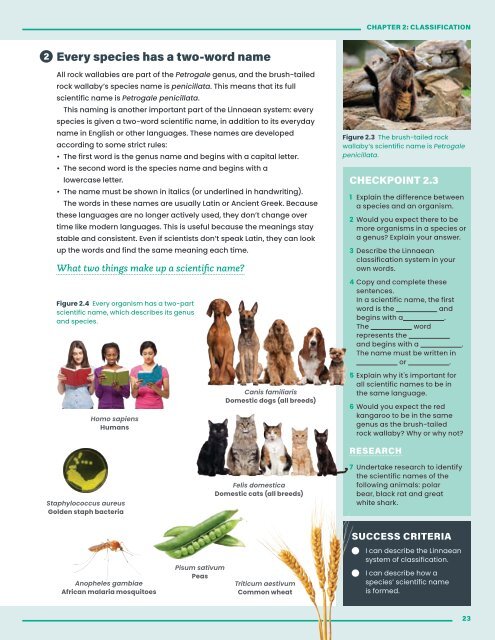Good Science Victorian Curriculum Year 7
Digital sample of Matilda's newest publication, Good Science Victorian Curriculum Year, authored by Emma Craven and Aaron Elias. For more information visit www.matildaeducation.com.au or email Katrina Tucker, katrinatucker@matildaed.com.au
Digital sample of Matilda's newest publication, Good Science Victorian Curriculum Year, authored by Emma Craven and Aaron Elias. For more information visit www.matildaeducation.com.au or email Katrina Tucker, katrinatucker@matildaed.com.au
Create successful ePaper yourself
Turn your PDF publications into a flip-book with our unique Google optimized e-Paper software.
CHAPTER 2: CLASSIFICATION<br />
2<br />
Every species has a two-word name<br />
All rock wallabies are part of the Petrogale genus, and the brush-tailed<br />
rock wallaby’s species name is penicillata. This means that its full<br />
scientific name is Petrogale penicillata.<br />
This naming is another important part of the Linnaean system: every<br />
species is given a two-word scientific name, in addition to its everyday<br />
name in English or other languages. These names are developed<br />
according to some strict rules:<br />
• The first word is the genus name and begins with a capital letter.<br />
• The second word is the species name and begins with a<br />
lowercase letter.<br />
• The name must be shown in italics (or underlined in handwriting).<br />
The words in these names are usually Latin or Ancient Greek. Because<br />
these languages are no longer actively used, they don’t change over<br />
time like modern languages. This is useful because the meanings stay<br />
stable and consistent. Even if scientists don’t speak Latin, they can look<br />
up the words and find the same meaning each time.<br />
What two things make up a scientific name?<br />
Figure 2.4 Every organism has a two-part<br />
scientific name, which describes its genus<br />
and species.<br />
Homo sapiens<br />
Humans<br />
Canis familiaris<br />
Domestic dogs (all breeds)<br />
Figure 2.3 The brush-tailed rock<br />
wallaby’s scientific name is Petrogale<br />
penicillata.<br />
CHECKPOINT 2.3<br />
1 Explain the difference between<br />
a species and an organism.<br />
2 Would you expect there to be<br />
more organisms in a species or<br />
a genus? Explain your answer.<br />
3 Describe the Linnaean<br />
classification system in your<br />
own words.<br />
4 Copy and complete these<br />
sentences.<br />
In a scientific name, the first<br />
word is the<br />
and<br />
begins with a .<br />
The<br />
word<br />
represents the<br />
and begins with a .<br />
The name must be written in<br />
or .<br />
5 Explain why it’s important for<br />
all scientific names to be in<br />
the same language.<br />
6 Would you expect the red<br />
kangaroo to be in the same<br />
genus as the brush-tailed<br />
rock wallaby? Why or why not?<br />
Staphylococcus aureus<br />
Golden staph bacteria<br />
Felis domestica<br />
Domestic cats (all breeds)<br />
RESEARCH<br />
7 Undertake research to identify<br />
the scientific names of the<br />
following animals: polar<br />
bear, black rat and great<br />
white shark.<br />
SUCCESS CRITERIA<br />
Anopheles gambiae<br />
African malaria mosquitoes<br />
Pisum sativum<br />
Peas<br />
Triticum aestivum<br />
Common wheat<br />
I can describe the Linnaean<br />
system of classification.<br />
I can describe how a<br />
species’ scientific name<br />
is formed.<br />
23


















